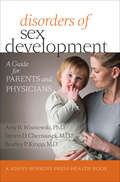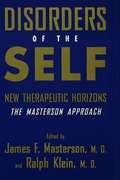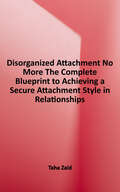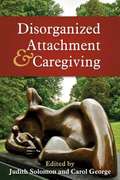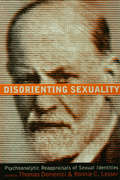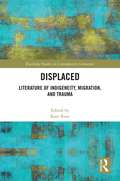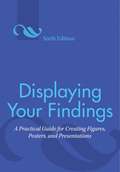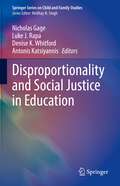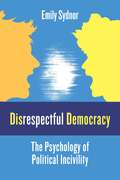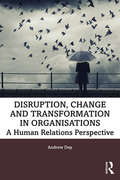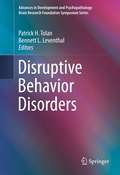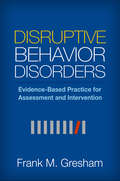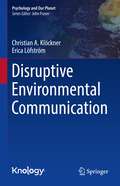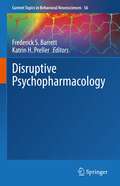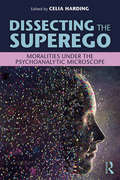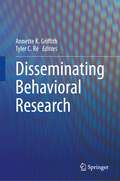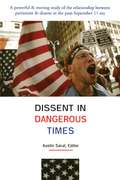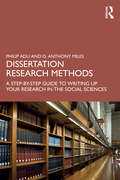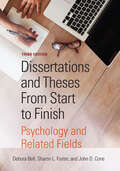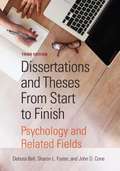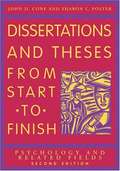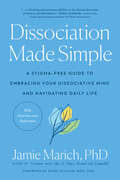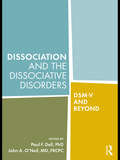- Table View
- List View
Disorders of Sex Development: A Guide for Parents and Physicians (A Johns Hopkins Press Health Book)
by Amy B. Wisniewski Steven D. Chernausek Bradley P. KroppCompassionately written by an experienced team of professionals, this book offers parents and families essential information about the causes, diagnosis, and treatment of disorders of sex development, or DSD.DSD refers to medical conditions, usually discovered at birth, in which there is disagreement between a person's genetic sex (i.e., chromosomes) and the appearance of the person's external or internal reproductive structures. After their child is diagnosed with DSD, parents need answers to a host of questions, including• What is DSD, why does it occur, how is it identified, and how is it treated?• Did we do something to cause our child's DSD?• Is my baby a boy or a girl?• Will my child grow up to be normal and healthy?• Does my child need surgery?This concise book answers parents' questions in a reassuring and forthright way, giving affected individuals, their families, and their health care providers a current and evidence-based picture of DSD. It offers clear explanations of how newborns with DSD are evaluated, diagnosed, and treated; describes the different kinds of DSD; and pays close attention to both psychosocial and medical aspects of DSD. This guide also includes information about the importance of support groups and education for affected individuals and their families.In their daily work, the authors treat, support, and educate people with DSD and their families. This resource gives parents and families access to the authors' expertise so they can reach a meaningful understanding of their child's DSD and make informed decisions about their child's health.
Disorders of the Self: New Therapeutic Horizons: The Masterson Approach
by James F. Masterson Ralph KleinFirst published in 1996. Routledge is an imprint of Taylor & Francis, an informa company.
Disorganized Attachment No More!: The Complete Blueprint to Achieving a Secure Attachment Style in Relationships
by Taha ZaidIt's time to control those overflowing emotions, understand your patterns, and identify the way forward toward a healthier, happier relationship. Have you been dealing with a rollercoaster of emotions that seem to create roadblocks to your happiness? Do you sometimes feel it would be easier if you stayed single because you didn't want to put someone through your spinning thoughts? Do you self-sabotage when it comes to deciding what you need to do and your happiness? Listen, the most common culprit for blocking our own happiness is us. The negativity that you have accumulated over your life, from childhood till now, has been clouding your decision-making and causing you to see life in gray. You see, past experiences have a way of seeping into our present and future. They have the power to create an environment where you overthink and overanalyze every little detail–what a person said, how you responded, their body language, your own body language…the list goes on and on! That is what stops you from having your happily ever after. You are probably dealing with disorganized attachment, but you aren’t really sure what that means. Science has categorized it as a disorder, and luckily, it's a condition that is treatable. This is your chance to go from disorganized attachment to healthy relationships and from chaotic emotions to a more focused outlook on life. It's time to truly tap into the details of your past to create a happier future. In this practical guide, you will discover: - The nooks and crannies of insecure attachments that can help you understand disorganized attachment even more - The image of a healthy relationship – uncover exactly what it takes to build that secure connection with that special someone - Techniques to pinpoint the signs of disorganized attachment in yourself and others that will open your eyes to a new world of emotions - Methods of emotional control to truly face your fears, understand your past childhood trauma, and pinpoint your triggers - How to save your relationship by focusing on yourself and using the power of communication - The art of improvement, from how to improve your self-worth to your confidence so you can go through your adult life more organized - How to move forward in life with various techniques like self-healing and building yourself up And much more. When it comes to keeping your relationships safe, taking the step to improving your own skills and confidence might be the key you have been looking for. With this guide, you can understand where your feelings are from and how to deal with them.
Disorganized Attachment and Caregiving
by Carol George Judith SolomonIn this volume, leading authorities provide a state-of-the-art examination of disorganized attachment what it is, how it can be identified, and its links to behavioral problems and psychological difficulties in childhood and beyond. The editors offer a fresh perspective on disorganized attachment, not as a characteristic of the infant or child but as the product of a dysregulated and disorganized parent child relationship. They present cutting-edge research and exemplary treatment approaches. With attention to the subjective experiences of both mothers and children, the book shows how focusing on the care giving system can advance research and clinical practice.
Disorienting Sexuality: Psychoanalytic Reappraisals of Sexual Identities
by Ronnie C. Lesser Thomas DomeniciDisorienting Sexuality exposes the biases against gay men and lesbians in psychoanalytic theory and practice. In the introduction, Domenici and Lesser draw a brief history of anti-homosexual sentiment in psychoanalysis. The book then moves into essays written by lesbian and gay psychoanalysts seeking to have a voice in the reshaping of psychoanalytic theories of sexuality. The second section is devoted to presenting different theoretical perspectives for understanding both homosexuality and heterosexuality. Disorienting Sexuality concludes with the personal narratives of gay and lesbian psychoanalysts.
Disparities in School Readiness: How Families Contribute to Transitions into School
by Alan Booth • Ann C. CrouterSignificant disparities exist in children's behavioral and learning capacities that support successful transitions into school. In this new volume, leading researchers from a variety of disciplines review the latest data on how families influence their children's transitions into school. The inequalities that exist in school readiness, the roots of
Displaced: Literature of Indigeneity, Migration, and Trauma (Routledge Studies in Contemporary Literature)
by Kate RoseThrough specific and rigorous analysis of contemporary literary texts, this book shows how writers from inside effected communities portray indigeneity, displacement, and trauma. In a world of increasing global inequality, this study aims to demonstrate how literature, and the study of it, can effect positive social change, notably in the face of global environmental, economic, and social injustice. This collection brings together a diverse and compelling array of voices from academics leading their fields around the world, to pioneer a new approach to literary analysis anchored in engagement with our changing world.
Displaying Your Findings: A Practical Guide For Creating Figures, Posters, And Presentations
by Adelheid Nicol Penny PexmanThis new edition offers readers essential guidance on creating figures that effectively present their findings. Figure examples have been updated to reflect reporting standards and graphics presentation outlined in the sixth edition of the Publication Manual.
Disproportionality and Social Justice in Education (Springer Series on Child and Family Studies)
by Nicholas Gage Luke J. Rapa Denise K. Whitford Antonis KatsiyannisThis book examines disproportionality in education, focusing on issues of social justice for diverse and marginalized students. It addresses disproportionality as an indicator of biased practices and uses social justice as the frame for conceptualizing disproportionality historically and as a means to improve educational practice. Chapters explore the historical issue of disproportionality in education; outcomes experienced by racially and ethnically diverse students and students with disabilities, including discipline, bullying, and academic achievement; and ways in which social justice can inform policy and practice to make a positive impact reducing disproportionality in education. Key areas of coverage include:Methodological and statistical concerns in disproportionality research in education.Reviews research and data on disproportionality in education (e.g., disciplinary exclusion, bullying, seclusion and restraint, corporal punishment, school-based arrests, and academic achievement).Social justice as a theoretical and legal driver for change in policy and practice.Educational assessment and intervention practices designed to address disproportionality in education. Disproportionality and Social Justice in Education is a must-have resource for researchers, professors, and graduate students as well as clinicians, practitioners, and policymakers across such disciplines as clinical child and school psychology, educational psychology and teaching and teacher education, social work and counselling, pediatrics and school nursing, educational policy and politics, public health, and all interrelated disciplines.
Disrespectful Democracy: The Psychology of Political Incivility
by Professor Emily SydnorThe majority of Americans think that politics has an “incivility problem” and that this problem is only getting worse. Research demonstrates that negativity and rudeness in politics have been increasing for decades. But how does this tide of impolite-to-outrageous language affect our reactions to media coverage and our political behavior?Disrespectful Democracy offers a new account of the relationship between incivility and political behavior based on a key individual predisposition—conflict orientation. Individuals experience conflict in different ways; some enjoy arguments while others are uncomfortable and avoid confrontation. Drawing on a range of original surveys and experiments, Emily Sydnor contends that the rise of incivility in political media has transformed political involvement. Citizens now need to be able to tolerate or even welcome incivility in the public sphere in order to participate in the democratic process. Yet individuals who are turned off by incivility are not brought back in by civil presentation of issues. Sydnor considers the challenges in evaluating incivility’s normative benefits and harms to the political system: despite some detrimental aspects, certain levels of incivility in certain venues can promote political engagement, and confrontational behavior can be a vital tool in the citizen’s democratic arsenal. A rigorous and empirically informed analysis of political rhetoric and behavior, Disrespectful Democracy also proposes strategies to engage citizens across the range of conflict orientations.
Disruption, Change and Transformation in Organisations: A Human Relations Perspective
by Andrew DayThis book explores the psychological and social dynamics of continuous, disruptive and discontinuous change. It examines the emotional strain and challenges of disruption, studies the nature of organisational transformation and examines what can be done to develop an organisation’s capacity to adapt and thrive in turbulent environments. An organisation’s long-term survival increasingly rests on its adaptive capacity, ability to continuously change and transform itself. Yet, people experience ongoing and fundamental change to be disorientating and unsettling as it challenges accepted assumptions and identities. This book assists leaders and change practitioners understand these dynamics, help people to make sense of change and to create the conditions that enable people to self-organise and creatively adapt. With case studies and personal accounts from individuals and companies, this is an ideal resource for practitioners and managers dealing with organisational change, as well as students, academics and researchers.
Disruptive Behavior Disorders
by Patrick H. Tolan Bennett L. LeventhalAggressive behavior among children and adolescents has confounded parents and perplexed professionals--especially those tasked with its treatment and prevention--for countless years. As baffling as these behaviors are, however, recent advances in neuroscience focusing on brain development have helped to make increasing sense of their complexity. Focusing on their most prevalent forms, Oppositional Defiant Disorder and Conduct Disorder, Disruptive Behavior Disorders advances the understanding of DBD on a number of significant fronts. Its neurodevelopmental emphasis within an ecological approach offers links between brain structure and function and critical environmental influences and the development of these specific disorders. The book's findings and theories help to differentiate DBD within the contexts of normal development, non-pathological misbehavior, and non-DBD forms of pathology. Throughout these chapters are myriad implications for accurate identification, effective intervention, and future cross-disciplinary study. Key issues covered include: Gene-environment interaction models.Neurobiological processes and brain functions.Callous-unemotional traits and developmental pathways.Relationships between gender and DBD.Multiple pathways of familial transmission. Disruptive Behavior Disorders is a groundbreaking resource for researchers, scientist-practitioners, and graduate students in clinical child and school psychology, psychiatry, educational psychology, prevention science, child mental health care, developmental psychology, and social work.
Disruptive Behavior Disorders
by Frank M. GreshamSchools often resort to ineffective, punitive interventions for the 10% of K-8 students whose challenging behavior interferes with their own and their classmates' learning. This book fills a crucial need by describing ways to provide meaningful supports to students with disruptive behavior disorders. Prominent authority Frank M. Gresham weaves together current research, assessment and intervention guidelines, and illustrative case studies. He reviews a broad range of evidence-based practices and offers recommendations for selecting, implementing, and evaluating them within a multi-tiered framework. Coverage includes school- and home-based approaches, multicomponent programs, prevention strategies, and social skills training.
Disruptive Environmental Communication (Psychology and Our Planet)
by Christian A. Klöckner Erica LöfströmThis book proposes a radical change in communication strategies about environmental problems, advocating for more active and emotionally engaging methods that drive people to action. Based on new theoretical developments and research, the book provides a new framework for designing such communication strategies and suggests practical implementations of these ideas for practitioners, policy-makers, and scientists. Among the topics discussed: • The psychology of change and why disruptive communication is necessary • Virtual reality technologies used to communicate complex ideas • Reflections on the value of science fiction and climate fiction in addressing environmental issues • Analyzing the impact of youth climate activism Disruptive Environmental Communication provides an innovative new framework for designing effective communication strategies to address large-scale environmental problems, challenging the assumption that environmental problems can be communicated and handled through non-disruptive methods.
Disruptive Psychopharmacology (Current Topics in Behavioral Neurosciences #56)
by Frederick S. Barrett Katrin H. PrellerPsychedelic therapies are gaining traction as potential treatments for a wide range of indications, but the structure and delivery of psychedelic therapies are a sharp departure from more traditional models of psychotherapy and pharmacotherapy for psychiatric and other medical disorders. This may be critical to their success. The current volume provides a comprehensive review of the state of the science of psychedelic therapies, including discussion of models and approaches to psychedelic therapies as well as the current status of safety and efficacy data for mood, substance use, trauma, obsessive-compulsive, neurodevelopmental, neurodegenerative disorders, neurological, and inflammatory disorders.
Dissecting the Superego: Moralities Under the Psychoanalytic Microscope
by Celia HardingDissecting the Superego: Moralities Under the Psychoanalytic Microscope offers a comprehensive overview of how the superego, the workings of our moral faculties, may be understood and clinically utilised in contemporary practice. Drawing on the latest psychoanalytic thinking – as well as neurobiological, psychological and ethical perspectives- this book reinstates the superego as a central concept, and gives a clear guide to its importance in the modern world. In addition to the theoretical background of this construct, the contributors provide a clear guide to the importance of the superego in a range of pathological and everyday scenarios, and particularly in clinical settings. With an emphasis on the wider social and cultural context, Dissecting the Superego: Moralities Under the Psychoanalytic Microscope will be of interest to trainee and qualified psychotherapists, social workers, youth offender and probation workers and ethicists.
Disseminating Behavioral Research
by Annette K. Griffith Tyler C. RéDissemination is a key component of the research process. While several fields have developed resources dedicated to training and supporting their scientists and practitioners as they are encouraged to disseminate within their fields and to the larger public audience, there has been a lack of formal guidance for dissemination within the behavioral sciences. Disseminating Behavioral Science aims to fill that gap, providing guidance across modalities for topics ranging from the peer-review process to conference presentation to nontraditional avenues for dissemination. The contents of this edited text, divided across six sections, serves as a roadmap for students, junior researchers, and senior scholars. The first section includes types of academic scholarship, types of dissemination, and strategies to ensure ethical dissemination. The second reviews traditional publication preparation, including tips for the writing process and key components to include in each section of a scientific manuscript. Section Three explores publication within a traditional peer reviewed journal. Section Four outlines additional strategies to get research publicly recognized through conference presentations, social media and popular media sources, and white and grey literature. Sections Five and Six offer a consolidated glossary of all key terms in the text and combined reference list.
Dissent in Dangerous Times
by Austin SaratWhile dissent has played a central role in our national history and in the American cultural imagination, it is usually dangerous to those who practice it, and always unpalatable to its targets. War does not encourage the tolerance of opposition at home any more than it does on the front: if the War on Terror is to be a permanent war, then the consequences for American political freedoms cannot be overestimated.
Dissertation Research Methods: A Step-by-Step Guide to Writing Up Your Research in the Social Sciences
by Philip Adu D. Anthony MilesDissertation Research Methods: A Step-by-Step Guide to Writing Up Your Research in the Social Sciences focuses specifically on the methodology for planning, writing and submitting your dissertation thesis. Written by two methodology experts in the social sciences, the book provides a step-by-step guide through each stage of the dissertation process. It covers all aspects of the methodological considerations needed, from choosing a topic or research question, developing a literature review, identifying research gaps, accessing potential study participants, utilizing the right sampling strategies, analyzing data and writing up findings. Readers are introduced to the main research methods normally used in dissertations and their characteristics, and they are guided to choose an appropriate research method for their study, provide a substantial description of the selected method and articulate strong arguments in support of it. The book is filled with templates, exemplars and tools to help students write about methodology in their thesis and to equip readers to successfully troubleshoot any methodology challenges they may face. This compact book will be of use to all graduate students and their supervisors in the Social Sciences and Education and Behavioural Sciences who are looking for a guide to working with robust and defensible methodological principles in their dissertation research and theses.
Dissertations and Theses From Start to Finish: Psychology and Related Fields
by Debora J. Bell Dr. Sharon L. Foster Dr. John D. ConeDissertations and Theses From Start to Finish, now updated and revised to reflect changes to the APA's Publication Manual, Seventh Edition! For over twenty-five years, Cone and Foster's useful book has guided student writers through the practical, logistical, and emotional struggles that come with writing dissertations and theses. It offers guidance to students through all the essential steps, including: Defining topics; Selecting faculty advisors; Scheduling time to work on the project, and; Conducting, analyzing, writing, presenting, and publishing research. This third edition of this bestselling work follows new guidelines from APA's Publication Manual, Seventh Edition, and includes questions to help steer research, checklists, diagrams, and sample research papers. It also reflects the most recent advances in online research and includes fully updated online resources. Each chapter begins with an Advance Organizer that offers an at-a-glance summary of chapter content and applicability for different types of readers. Chapters also include significantly expanded To Do and Supplemental Resource lists, as well as helpful suggestions for dealing with common &“traps&” that recur throughout the writing process. The authors also consider the variety of roles faculty advisors play, and of variations in the thesis and dissertation process and requirements across institutions of higher learning.
Dissertations and Theses from Start to Finish: Psychology and Related Fields
by John D. Cone Sharon L. Foster Debora J. BellThis book includes questions to help steer research, checklists, diagrams, and sample research papers. It also reflects the most recent advances in online research and includes fully updated online resources. Each chapter begins with an Advance Organizer that offers an at-a-glance summary of chapter content and applicability for different types of readers. Chapters also include significantly expanded To Do and Supplemental Resource lists, as well as helpful suggestions for dealing with common "traps" that recur throughout the writing process. The authors also consider the variety of roles faculty advisors play, and of variations in the thesis and dissertation process and requirements across institutions of higher learning.
Dissertations and Theses from Start to Finish: Psychology and Related Fields
by John D. Cone Sharon L. FosterA book written by two long-time professors to help graduate students in psychology and related fields negotiate the thesis and dissertation process from beginning to end. Annotation c. by Book News, Inc., Portland, Or.
Dissimulation and Deceit in Early Modern Europe
by Miriam Eliav-Feldon Tamar HerzigIn this book, twelve scholars of early modern history analyse various categories and cases of deception and false identity in the age of geographical discoveries and of forced conversions: from two-faced conversos to serial converts, from demoniacs to stigmatics, and from self-appointed ambassadors to lying cosmographer.
Dissociation Made Simple: A Stigma-Free Guide to Embracing Your Dissociative Mind and Navigating Daily Life
by Jamie MarichDissociation 101: The go-to guide for understanding your dissociative disorder, breaking the stigma, and healing from trauma-related dissociation.Guided by clinical counselor Jamie Marich—a trauma-informed clinician living with a dissociative disorder herself—this book tells you everything you need to know about dissociation...but were too afraid to ask. Here, you&’ll learn:What dissociation is—and why it&’s a natural response to traumaHow to understand and work with your &“parts&”—the unique emotional and behavioral profiles that can develop from personality fragmentationThere&’s nothing shameful about dissociating—that, in fact, we can all dissociateSkills and strategies for living your best, authentic, and most fulfilled lifeWhat to look for in a therapist: choosing a healer who sees you and gets itFoundational elements of healing from trauma, including PTSD and C-PTSD With practical guided exercises like &“The Dissociative Profile&” and &“Parts Mapping,&” this book is written for those diagnosed with dissociative disorders, clinicians and therapists who treat trauma and dissociation, and readers who are exploring whether they may have dissociative symptoms or a condition like dissociative identity disorder (DID). Dissociation Made Simple breaks it all down accessibly and comprehensively, with empowerment and support—and without stigma, judgment, or shame.
Dissociation and the Dissociative Disorders: DSM-V and Beyond
by Paul F. DellWinner of ISSTD's 2009 Pierre Janet Writing Award for the best publication on dissociation in 2009! Dissociation and the Dissociative Disorders is a book that has no real predecessor in the dissociative disorders field. It reports the most recent scientific findings and conceptualizations about dissociation; defines and establishes the boundaries of current knowledge in the dissociative disorders field; identifies and carefully articulates the field’s current points of confusion, gaps in knowledge, and conjectures; clarifies the different aspects and implications of dissociation; and sets forth a research agenda for the next decade. In many respects, Dissociation and the Dissociative Disorders both defines and redefines the field.
